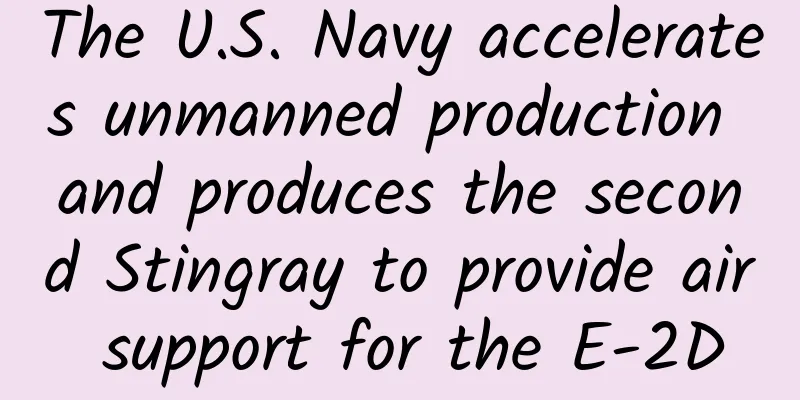The U.S. Navy accelerates unmanned production and produces the second Stingray to provide air support for the E-2D

|
On August 18, 2021, a U.S. Navy E-2D Hawkeye aircraft became the second aircraft to provide aerial refueling by a Boeing-owned MQ-25 Stingray test aircraft since June 4. After making wake measurements, a newly installed probe on a Northrop Grumman command and control aircraft receives fuel from a refueling pod mounted on the inboard portion of the left wing of an MQ-25 test aircraft. "This flight allows us to quickly get the Stingray into the fleet," said Captain Chad Reed, the Navy's unmanned carrier aviation program manager. "Its refueling capability will greatly increase the range and operational flexibility of the carrier air wing and strike group." The E-2D and MQ-25 remained in the air for six hours. During the flight, a series of contacts between the refueling probe and the buoy basket were made at a calibrated airspeed (KCAS) of 407.44 kilometers per hour (220 knots) and an altitude of 3,048 meters (10,000 feet), according to Naval Air Systems Command. The MQ-25 test aircraft previously refueled an F/A-18F on June 4, 2021, marking the first time a manned aircraft received fuel from a drone. On June 7, 2021, the U.S. Naval Air Systems Command and Boeing issued a statement that the MQ-25 "Stingray" unmanned tanker T1 prototype successfully carried out the first aerial refueling for an F/A-18 F carrier-based fighter. The test was conducted at the Central American Airport in Mascoutah, Illinois. The MQ-25 unmanned tanker was equipped with a soft refueling vehicle, successfully extended the refueling hose during flight, and safely injected fuel into an F/A-18 F "Super Hornet" fighter of the U.S. Navy. The distance between the MQ-25 drone and the "Super Hornet" refueling boom was only 6 meters, demonstrating that the MQ-25 already has the ability to perform aerial refueling missions. "These historic refueling flights provided an incredible amount of data that we fed back into the MQ-25 digital model to ensure we produce an aircraft that will be a game changer for the Navy's carrier air wing," said Dave Bujold, Boeing's MQ-25 program director. The MQ-25 unmanned tanker is an important part of the U.S. Navy's future combat system. It will be able to provide 6.35 tons (originally 14,000 pounds) to 7.26 tons (originally 16,000 pounds) of fuel to other aircraft within a range of 926 kilometers (originally 500 nautical miles). According to the US Navy's expectations, the MQ-25 Stingray carrier-based unmanned tanker needs to ensure that it can provide at least 6.8 tons of fuel to 4-6 F/A-18E/F Super Hornet carrier-based fighters within 500 nautical miles (about 926 kilometers), increasing the latter's maximum combat radius, that is, the aircraft carrier's strike radius, from the original 830 kilometers to 1,300 kilometers. The Navy plans to begin deploying MQ-25s to carriers in fiscal 2025, seven years after the contract was awarded. The 10th Carrier Multi-Role UAV Squadron (VUQ-10) will be established later this year to begin preparations for its first deployment four years later. USNI News previously reported that the USS George H.W. Bush (CVN-77) will become the first aircraft carrier equipped with the carrier's Unmanned Aircraft Mission Control System (UMCS) to operate the aircraft. The current procurement plan of the U.S. Navy is 4 test aircraft + 3 test aircraft (added in 2020) + 72 mass-produced aircraft, with 4 mass-produced aircraft to be incorporated in 2023 and 2024 respectively, and the low-speed production of 12 aircraft will be switched to full-speed production. In 2018, Boeing won an $805 million contract to build the first four Stingrays, beating out General Atomics and Lockheed Martin to develop an unmanned carrier tanker. In 2020, the U.S. Navy executed an $84.7 million contract to buy three more Stingrays. After that, the U.S. Navy will purchase 72 MQ-25As at a price of $1.3 billion, and plans to announce that the MQ-25A has initial operational capability (IOC) in 2025. The U.S. Navy uses hose refueling, while the U.S. Air Force uses hard pipe refueling At the same time, Boeing also has ambitions to add other functions to the MQ-25 to compete for related projects of the US Navy's "loyal wingman". For example, Boeing has stated that the first updated iteration of the MQ-25 platform also has some intelligence, surveillance and reconnaissance capabilities. It is expected that these capabilities will grow over time and may even be used as a weapon launch platform in the future. The MQ-25A can taxi and take off autonomously. Once it is integrated onto an aircraft carrier, it will quickly adapt to the new combat environment. In addition, the MQ-25 is actually quite large, although it may not be noticeable from a single glance. The main purpose of the US Navy's development of the MQ-25 is to "liberate" the F/A-18E/F "Super Hornet" fighter. Due to the lack of carrier-based tankers (the C2 Greyhound tanker has been retired, and the Osprey tanker is still in the planning stage), a considerable number of "Super Hornets" have been playing this role through buddy refueling, and can only refuel the same type of aircraft. According to the US Navy's own statement, these "Super Hornet" fighter fleets have actually become tankers for the aircraft carrier air wing. Up to 25% to 30% of the flight time of the "Super Hornet" fighter is used to serve as a tactical tanker for the air wing. This is equivalent to reducing the fighters that can be used for air defense or attack missions in disguise. F/A-18 carrier-based aircraft conducts buddy refueling operations The U.S. Navy itself thinks the MV-22B Osprey as a tanker is not a good idea Although the MQ-25 will take up some deck space, it will free up the F-18 and allow it to refuel the F-35C and even the Navy's sixth-generation aircraft (NGAD) in the future, which is very cost-effective. Of course, there are controversies. Assuming that the Stingray refuels the Super Hornet 500 nautical miles away from the mother ship, increasing the latter's combat radius to 1,300 kilometers, after the attack is completed, the Stingray cannot ignore the Super Hornet, but must go to meet it at a similar distance, or even further, because the fuel consumption of the fighter will be relatively large after the fierce battle, then the problem of the Stingray's own endurance and dispatch efficiency will follow. In this case, large land-based tankers that take off from US air bases, stay in the air for a long time and do not take up space on the aircraft carrier deck are very advantageous, such as the KC-46A tanker. The US Air Force has purchased as many as 179 of them, but their performance is not very reliable at present. The U.S. Air Force's KC-46 tanker refuels the U.S. Navy's Blue Angels F/A-18 Hornet. The U.S. Air Force uses hard-pipe refueling, while the U.S. Navy uses soft-pipe refueling. The KC-46 has two systems. Previously, due to problems with the KC-46's own system, it was not possible to use the soft-pipe system to refuel the Navy system. On July 9, 2021, the U.S. Air Force Air Mobility Command experimentally opened this function. Of course, the US Navy believes that in a battle with an enemy of "equal level", the safety of the US Air Force's large tanker aircraft is worrying. Whether the aircraft itself is killed by an "invisible assassin" or the base is "expressed", it is a "close and pressing threat". In this case, the US Navy must have its own mobile tanker aircraft. A country's ultra-long-range air-to-air missile The author does not rule out the possibility of a dispute between the U.S. Navy and Air Force, but in terms of maintaining redundancy, it is necessary for both the U.S. Navy and Air Force to retain a certain degree of aerial refueling capability. On future aircraft carriers, it is a general trend to use drones to replace some special aircraft and even fighter aircraft, such as unmanned early warning aircraft, unmanned tankers and unmanned wingmen. The ratio of manned to unmanned aircraft in the US Navy may be 4:6 in the future. The US Navy is not very interested in the F-35C, it is more looking forward to the next generation of air superiority fighter + drone combination. |
<<: The history of the development of Russian pistols, from the famous "Makarov" to the "Lebedev"
>>: Chinese names shining on Mercury
Recommend
Types and development trends of WeChat Moments ads in 2015: H5 ads become popular on the platform!
Since last year, WeChat has become a social platf...
8 short video transaction scripts
You may have spent thousands of dollars listening...
The buildings are there and the swallows are there, but they are “out of touch with reality”. Why are swifts long-term “residents” of Beijing?
Every spring and summer, agile figures can often ...
New gameplay of Douyin Blue V Matrix
1. What is a matrix? The advanced method of accou...
The legendary Qilin auspicious beast really exists! What kind of animal is it?
Friends who work hard in other places will bring ...
Tesla received a RMB 4 billion loan, mainly for the construction of its Shanghai factory
Recently, foreign media revealed that Tesla obtai...
“Grumpy when waking up”, what are you angry about?
Not getting satisfactory results: Angry! Not gett...
How to achieve user experience beyond expectations?
Each product iteration requires that the new user...
The sales volume of domestic brands has exploded, accounting for a much larger proportion than the total sales volume of German and Japanese brands
The domestic brand, which had experienced 14 cons...
How to leverage hot events to boost website traffic?
Website traffic has always been a common topic. N...
Southerners vs Northerners, who is fatter? The truth is...
People in the south are thinner than people in th...
Dismantling the big size: Without fission, how can we achieve monthly sales of tens of millions through social e-commerce?
The large model that we are going to disassemble ...
What should I do if my Tik Tok works are not recommended?
After the emergence of Kuaishou short video, shor...
The most comprehensive APP operation and promotion plan!
Now that you have the APP, the next step is to op...









